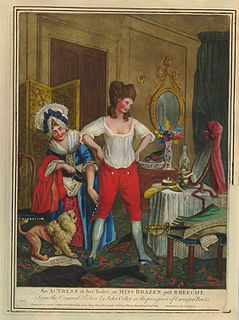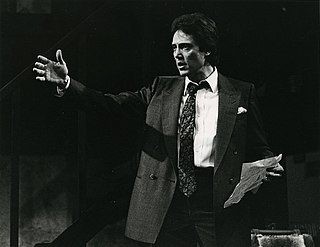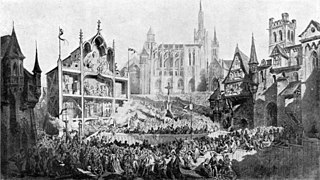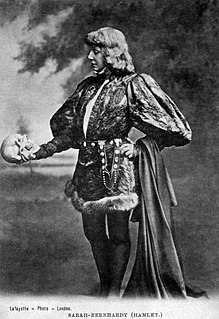 W
WDrama is the specific mode of fiction represented in performance: a play, opera, mime, ballet, etc., performed in a theatre, or on radio or television. Considered as a genre of poetry in general, the dramatic mode has been contrasted with the epic and the lyrical modes ever since Aristotle's Poetics —the earliest work of dramatic theory.
 W
WA play is a work of drama, usually consisting mostly of dialogue between characters and intended for theatrical performance rather than just reading. The writer of a play is a playwright.
 W
WThe theatrical genre of aqua drama that was popular in 19th century France, England, and the United States involved flooding the arenas of circuses for recreations of major naval conflicts and similar aquatic events; some venues participated to such a great extent in this once-popular form as to install permanent water-tanks on stage. Water-based spectacles, especially those portraying great naval battles, had been popular in Roman times, when they were known as naumachia, and the custom was resurrected at various times during the Middle Ages.
 W
WAugustan drama can refer to the dramas of Ancient Rome during the reign of Caesar Augustus, but it most commonly refers to the plays of Great Britain in the early 18th century, a subset of 18th-century Augustan literature. King George I referred to himself as "Augustus," and the poets of the era took this reference as apropos, as the literature of Rome during Augustus moved from historical and didactic poetry to the poetry of highly finished and sophisticated epics and satire.
 W
WA breeches role is one in which an actress appears in male clothing. Breeches, tight-fitting knee-length pants, were the standard male garment at the time these roles were introduced. The theatrical term travesti covers both this sort of cross-dressing and also that of male actors dressing as female characters. Both are part of the long history of cross-dressing in music and opera and later in film and television.
 W
WBurra Katha, also spelled Burrakatha, is an oral storytelling technique in the Jangam Katha tradition, performed in villages of Andhra Pradesh and Telangana. The troupe consists of one main performer and two co-performers. It is a narrative entertainment that consists of prayers, solo drama, dance, songs, poems and jokes. The topic will be either a Hindu mythological story or a contemporary social issue. It became popular art form during the Telangana Rebellion in the early 1930-1950.
 W
WIn fiction, a character is a person or other being in a narrative. The character may be entirely fictional or based on a real-life person, in which case the distinction of a "fictional" versus "real" character may be made. Derived from the ancient Greek word χαρακτήρ, the English word dates from the Restoration, although it became widely used after its appearance in Tom Jones in 1749. From this, the sense of "a part played by an actor" developed. Character, particularly when enacted by an actor in the theatre or cinema, involves "the illusion of being a human person". In literature, characters guide readers through their stories, helping them to understand plots and ponder themes. Since the end of the 18th century, the phrase "in character" has been used to describe an effective impersonation by an actor. Since the 19th century, the art of creating characters, as practiced by actors or writers, has been called characterisation.
 W
WTheatrical cold reading is reading aloud from a script or other text with little or no rehearsal, practice or study in advance. Sometimes also referred to as sight reading, it is a technique used by actors and other performers in theatre, television, and film performance fields.
 W
WComedy is entertainment consisting of jokes intended to make an audience laugh. For ancient Greeks and Romans a comedy was a stage-play with a happy ending. In the Middle Ages, the term expanded to include narrative poems with happy endings and a lighter tone. In this sense Dante used the term in the title of his poem, the Divine Comedy.
 W
WThe comedy of intrigue, also known as the comedy of situation, is a genre of comedy in which dramatic action is prioritised over the development of character, complicated strategems and conspiracies drive the plot, and farcical humour and contrived or ridiculous dramatic situations are often employed. Characterisation tends to be defined only vaguely and the plot gives the illusion of dynamic, constant movement. The German philosopher Hegel argued that characters pursue their aims in such comedies via the use of deception. The genre was first developed in the theatre of classical Rome by Plautus and Terence. Examples of comedies of intrigue include Niccolò Machiavelli's The Mandrake (1524), the anonymous Italian play The Deceived Ones (1531), Shakespeare's The Merchant of Venice and "Much Ado About Nothing", Thomas Heywood's The Wise Woman of Hoxton, Molière's Scapin the Schemer (1671), and the plays of Aphra Behn and Thomas D'Urfey.
 W
WThere are many methods for teaching Drama. Each strategy involves varying levels of student participation.
 W
WFit-up refers to the old style of theatre or circus where companies of travelling players or performers would tour from town or village to village in the provinces of Britain and elsewhere, particularly throughout the 19th-century. Taken from the noun 'Fit-up', the term is theatre slang to describe a stage or tent or booth that can be transported and erected quickly for shows. A fit-up company would be a travelling company of players which carries its scenery, props and costumes that can be set up in a temporary venue - which might be a large tent or a village hall. 'Fit-up' companies were particularly prevalent in 19th-century Ireland and a study of the performance histories of these has been made by Irish academics. The oldest of these Irish companies included the J. B. Carrickford Company and Tommy Conway/Keegan, who formed the Bohemian Minstrels in the early 19th-century.
 W
WFolk plays such as Hoodening, Guising, Mummers Play and Soul Caking are generally verse sketches performed in countryside pubs in European countries, private houses or the open air, at set times of the year such as the Winter or Summer solstices or Christmas and New Year. Many have long traditions, although they are frequently updated to retain their relevance for modern audiences.
 W
WHeroic drama is a type of play popular during the Restoration era in England, distinguished by both its verse structure and its subject matter. The subgenre of heroic drama evolved through several works of the middle to later 1660s; John Dryden's The Indian Emperour (1665) and Roger Boyle's The Black Prince (1667) were key developments.
 W
WThe intermedio [interˈmɛːdjo], in the Italian Renaissance, was a theatrical performance or spectacle with music and often dance, which was performed between the acts of a play to celebrate special occasions in Italian courts. It was one of the important predecessors to opera, and an influence on other forms like the English court masque. Weddings in ruling families and similar state occasions were the usual occasion for the most lavish intermedi, in cities such as Florence and Ferrara. Some of the best documentation of intermedi comes from weddings of the House of Medici, in particular the 1589 Medici wedding, which featured what was undoubtedly both the most spectacular set of intermedi, and the best known, thanks to no fewer than 18 contemporary published festival books and sets of prints that were financed by the Grand Duke.
 W
WIn theatre, a monologue is a speech presented by a single character, most often to express their thoughts aloud, though sometimes also to directly address another character or the audience. Monologues are common across the range of dramatic media, as well as in non-dramatic media such as poetry. Monologues share much in common with several other literary devices including soliloquies, apostrophes, and asides. There are, however, distinctions between each of these devices.
 W
WMystery plays and miracle plays are among the earliest formally developed plays in medieval Europe. Medieval mystery plays focused on the representation of Bible stories in churches as tableaux with accompanying antiphonal song. They told of subjects such as the Creation, Adam and Eve, the murder of Abel, and the Last Judgment. Often they were performed together in cycles which could last for days. The name derives from mystery used in its sense of miracle, but an occasionally quoted derivation is from ministerium, meaning craft, and so the 'mysteries' or plays performed by the craft guilds.
 W
WA Nativity play or Christmas pageant is a play which recounts the story of the Nativity of Jesus. It is usually performed at Christmas, the feast of the Nativity.
 W
WOpera is a form of theatre in which music is a fundamental component and dramatic roles are taken by singers, but is distinct from musical theatre. Such a "work" is typically a collaboration between a composer and a librettist and incorporates a number of the performing arts, such as acting, scenery, costume, and sometimes dance or ballet. The performance is typically given in an opera house, accompanied by an orchestra or smaller musical ensemble, which since the early 19th century has been led by a conductor.
 W
WThe problem play is a form of drama that emerged during the 19th century as part of the wider movement of realism in the arts, especially following the innovations of Henrik Ibsen. It deals with contentious social issues through debates between the characters on stage, who typically represent conflicting points of view within a realistic social context. Critic Chris Baldick writes that the genre emerged "from the ferment of the 1890s... for the most part inspired by the example of Ibsen's realistic stage representations of serious familial and social conflicts." He summarises it as follows:Rejecting the frivolity of intricately plotted romantic intrigues in the nineteenth-century French tradition of the 'well-made play', it favoured instead the form of the 'problem play', which would bring to life some contemporary controversy of public importance—women's rights, unemployment, penal reform, class privilege—in a vivid but responsibly accurate presentation.
 W
WPunch and Judy is a traditional puppet show featuring Mr. Punch and his wife Judy. The performance consists of a sequence of short scenes, each depicting an interaction between two characters, most typically Mr. Punch and one other character who usually falls victim to Punch's slapstick. It is often associated with traditional British culture. The various episodes of Punch comedy—often provoking shocked laughter—are dominated by the clowning of Mr. Punch.
 W
WRealism in the theatre was a general movement that began in 19th-century theatre, around the 1870s, and remained present through much of the 20th century. It developed a set of dramatic and theatrical conventions with the aim of bringing a greater fidelity of real life to texts and performances. These conventions occur in the text, design, performance style, and narrative structure. They include recreating on stage a facsimile of real life except missing a fourth wall. Characters speak in naturalistic, authentic dialogue without verse or poetic stylings, and acting is meant to emulate human behaviour in real life. Narratives typically are psychologically driven, and include day-to-day, ordinary scenarios. Narrative action moves forward in time, and supernatural presences do not occur. Sound and music are diegetic only. Part of a broader artistic movement, it includes Naturalism and Socialist realism.
 W
WScreenwriting or scriptwriting is the art and craft of writing scripts for mass media such as feature films, television productions or video games. It is often a freelance profession.
 W
WSenecan tragedy refers to a set of ten ancient Roman tragedies, probably eight of which were written by the Stoic philosopher and politician Lucius Annaeus Seneca.
 W
WThe sock and buskin are two ancient symbols of comedy and tragedy. In ancient Greek theatre, actors in tragic roles wore a boot called a buskin. The actors with comedic roles wore only a thin-soled shoe called a sock.
 W
WA stock character is a stereotypical fictional person or type of person in a work of art such as a novel, play, or a film whom audiences recognize from frequent recurrences in a particular literary tradition. There is a wide range of stock characters, covering men and women of various ages, social classes and demeanors. They are archetypal characters distinguished by their simplification and flatness. As a result, they tend to be easy targets for parody and to be criticized as clichés. The presence of a particular array of stock characters is a key component of many genres, and they often help to identify a genre or subgenre. For example, a story with a knight-errant and a witch is probably a fairy tale or fantasy.
 W
WA talent show is an event in which participants perform the arts of singing, dancing, lip-syncing, acting, martial arts, playing an instrument, poetry, comedy or other activities to showcase skills. Many talent shows are performances rather than contests, but some are actual contests. In the instance of a contest, participants may be motivated to perform for a reward, trophy, or prize of some kind. For example, a high school might not have many students with any interest in performing in front of the student body for the sole purpose of performing alone and may offer different prizes as an incentive for these students to participate in the contest.
 W
WTom show is a general term for any play or musical based on the 1852 novel Uncle Tom's Cabin by Harriet Beecher Stowe. The novel attempts to depict the harsh reality of slavery. Due to the weak copyright laws at the time, a number of unauthorized plays based on the novel were staged for decades, many of them mocking the novel's strong characters and social message, and leading to the pejorative term "Uncle Tom".
 W
WTravesti is a theatrical term referring to the portrayal of a character in an opera, play, or ballet by a performer of the opposite sex.
 W
WThe well-made play is a dramatic genre from nineteenth-century theatre, developed by the French dramatist Eugène Scribe. It is characterised by concise plotting, compelling narrative and a largely standardised structure, with little emphasis on characterisation and intellectual ideas.